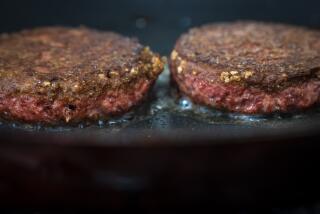Pink slime perspective
A century ago, cautious housewives demanded that the butcher grind their beef in front of them so they could be sure he didn’t toss in offal or scraps of lower-quality meat.
Not a bad idea for the modern grocery shopper who thinks that the way to get hamburger is to put a fine steak through a grinder. A modern package of ground beef is more likely to come from not one animal but several and, according to the Center for Science in the Public Interest, will probably include head meat, the esophagus and other internal organs.
And, of course, pink slime. That’s the less-than-thoroughly-accurate epithet bestowed on what the industry prefers to call lean, finely textured beef, which is made by salvaging the fatty scraps left after the animal has been butchered, putting it through a centrifuge to separate out the fat and treating it with ammonium hydroxide gas to raise the pH level and thus kill bacteria. Every few months there’s an outcry about the stuff. Recently, after it was reported that the trimmings are a routine part of the ground beef fed to children in U.S. public schools, parents demanded that the ingredient be dropped. In response, the U.S. Department of Agriculture announced this month that school districts would have a choice between receiving beef with the trimmings, or without but at a higher fat content. (The L.A. Unified School District serves smaller burgers rather than allow any fillers, including processed scraps.) On Wednesday, Safeway and Albertsons announced that they no longer would sell ground beef that contains pink slime.
But all we know for sure is that it sounds unappetizing; there’s no evidence that it isn’t safe or nutritious. The problem with consumer scares like this one is that they’re not based on data and facts but on instinct and rumor. Pink slime is not necessarily any more dangerous than many other industrial food practices. It’s true, as some parents have noted, that the European Union allows pink slime only in pet food. But then, Europe doesn’t allow a lot of things that are permitted in this country, including the use of synthetic hormones to raise beef cattle and the use of antibiotics to promote livestock growth. These might be just as bad or worse than pink slime, yet parents aren’t fighting to have them removed.
The Center for Science in the Public Interest, one of the staunchest consumer advocacy groups, told The Times that the fuss over pink slime, which the center considers safe, is a “tempest in a teapot” given what else goes into our food. And ammonium hydroxide is a fairly common antimicrobial additive in many foods. Should we stop eating those as well? Or should low-nutrition, highly processed foods such as white bread be a bigger worry?
Consumers might be surprised and bothered by many food company practices, even when they’re perfectly safe and, in some cases, natural. Carmine, a natural red food coloring, is made from ground-up bugs. Defending pink slime isn’t the aim here, but as consumers fight and win the beef-trimmings battle, they might be ignorant of — or ignoring — more troubling aspects of industrial food production.
More to Read
A cure for the common opinion
Get thought-provoking perspectives with our weekly newsletter.
You may occasionally receive promotional content from the Los Angeles Times.










